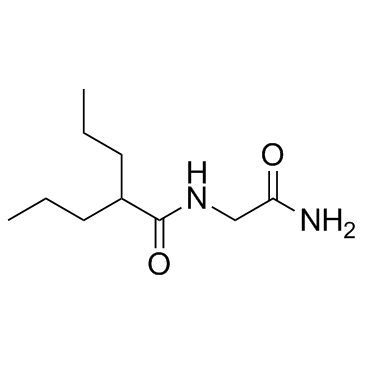92262-58-3
| Name | N-(2-amino-2-oxoethyl)-2-propylpentanamide |
|---|---|
| Synonyms |
UNII-1C7GO6OW7L
Valrocemide [INN] Valrocemide (USAN/INN) Valproyl glycinamide Vpgd cpd N-Valproylglycinamide N-(2-PROPYLPENTANOYL) GLYCINAMIDE N-(2-n-propylpentanoyl)-glycinamide valproylglycine amide TV-1901 Valrocemide |
| Description | Valrocemide (TV1901) is a promising antiepileptic drug candidate that shows a broad spectrum of anticonvulsant activity. |
|---|---|
| Related Catalog | |
| In Vivo | In mice, valrocemide affords complete protection against maximal electroshock-, pentylenetetrazole-, picrotoxin-, and bicuculline-induced seizures and 6-Hz “psychomotor” seizures with median effective dose (ED50) values of 151, 132, 275, 248, and 237 mg/kg, respectively. Valrocemide is also effective in preventing sound-induced seizures in Frings audiogenic-seizure susceptible mice (ED50, 52 mg/kg). The median neurotoxic dose in mice is 332 mg/kg. After oral administration to rats, valrocemide is active in the MES test, with an ED50 of 73 mg/kg, and the median neurotoxic dose is 1,000 mg/kg. Intraperitoneal administration of 300 mg/kg of valrocemide to hippocampal kindled Sprague–Dawley rats block generalized seizures and shorten the afterdischarge duration significantly. Valrocemide also provides complete protection from focal seizures in the corneally kindled rats (ED50, 161 mg/kg)[1]. |
| Animal Admin | Rats: Effect of valrocemide on the afterdischarge threshold in hippocampal kindled rats is evaluated in rats kindled according to this procedure. On the day of the test, the individual rat's afterdischarge threshold is determined by increasing the current intensity stepwise until the rat displayed an electrographic afterdischarge with duration of 4 s. For afterdischarge threshold determination, the initial stimulation is conducted at 20 μA and increased in 10-μA increments every 1–2 min until an afterdischarge is elicited. After administration of valrocemide, the individual rat's afterdischarge threshold is redetermined at times 0.5, 1, 2, and 4 h; ADD and BSS are recorded at each time point and compared with the control values obtained before drug administration. The criteria for seizure scoring is as described earlier for corneally kindled animals[1]. Mice: The intravenous (i.v.) pentylenetetrazole seizure threshold test (i.v. Met) also is used. At the TPE of valrocemide, infusion (0.34 ml/min) of 0.15% heparinized solution of pentylenetetrazole (0.5%) is started into the tail vein of a mouse, and the times to the appearance of the first myoclonic jerk and the subsequent sustained clonic seizure are recorded. A group of 10 drug-treated (132 mg/kg valrocemide, i.p.) mice is compared with 10 vehicle-treated controls. The time is converted to the dose of pentylenetetrazole in mg/kg. The i.v. Met test is performed according to the same procedure also after prolonged administration of valrocemide daily, i.p. (132 mg/kg) for 5 consecutive days[1]. |
| References |
| Density | 0.997 |
|---|---|
| Boiling Point | 417.5ºC at 760 mmHg |
| Molecular Formula | C10H20N2O2 |
| Molecular Weight | 200.27800 |
| Flash Point | 206.3ºC |
| Exact Mass | 200.15200 |
| PSA | 72.19000 |
| LogP | 1.89550 |
| Appearance | white solid |
| Index of Refraction | 1.465 |
| Storage condition | -20℃ |
| HS Code | 2924199090 |
|---|
| HS Code | 2924199090 |
|---|---|
| Summary | 2924199090. other acyclic amides (including acyclic carbamates) and their derivatives; salts thereof. VAT:17.0%. Tax rebate rate:13.0%. . MFN tariff:6.5%. General tariff:30.0% |
